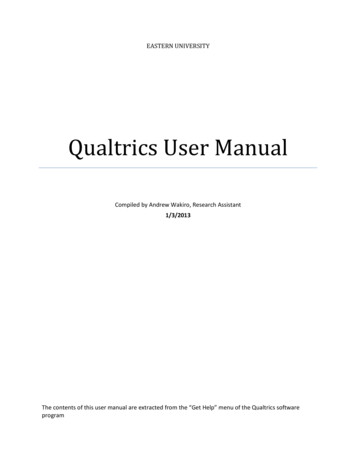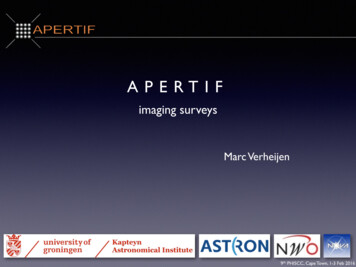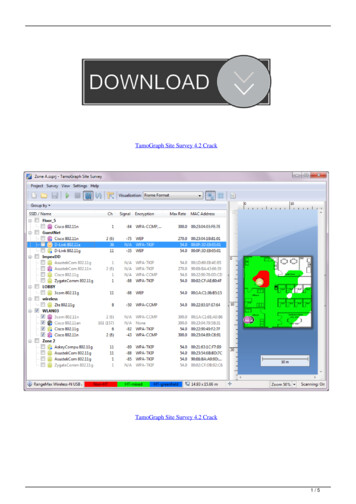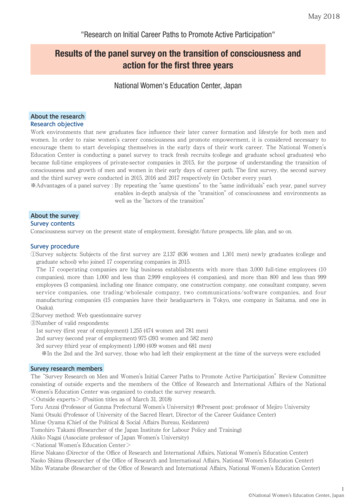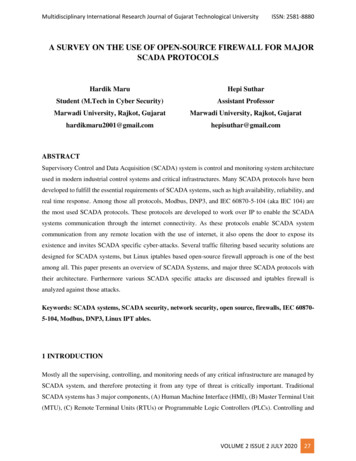
Transcription
Multidisciplinary International Research Journal of Gujarat Technological UniversityISSN: 2581-8880A SURVEY ON THE USE OF OPEN-SOURCE FIREWALL FOR MAJORSCADA PROTOCOLSHardik MaruHepi SutharStudent (M.Tech in Cyber Security)Assistant ProfessorMarwadi University, Rajkot, GujaratMarwadi University, Rajkot, mABSTRACTSupervisory Control and Data Acquisition (SCADA) system is control and monitoring system architectureused in modern industrial control systems and critical infrastructures. Many SCADA protocols have beendeveloped to fulfill the essential requirements of SCADA systems, such as high availability, reliability, andreal time response. Among those all protocols, Modbus, DNP3, and IEC 60870-5-104 (aka IEC 104) arethe most used SCADA protocols. These protocols are developed to work over IP to enable the SCADAsystems communication through the internet connectivity. As these protocols enable SCADA systemcommunication from any remote location with the use of internet, it also opens the door to expose itsexistence and invites SCADA specific cyber-attacks. Several traffic filtering based security solutions aredesigned for SCADA systems, but Linux iptables based open-source firewall approach is one of the bestamong all. This paper presents an overview of SCADA Systems, and major three SCADA protocols withtheir architecture. Furthermore various SCADA specific attacks are discussed and iptables firewall isanalyzed against those attacks.Keywords: SCADA systems, SCADA security, network security, open source, firewalls, IEC 608705-104, Modbus, DNP3, Linux IPT ables.1 INTRODUCTIONMostly all the supervising, controlling, and monitoring needs of any critical infrastructure are managed bySCADA system, and therefore protecting it from any type of threat is critically important. TraditionalSCADA systems has 3 major components, (A) Human Machine Interface (HMI), (B) Master Terminal Unit(MTU), (C) Remote Terminal Units (RTUs) or Programmable Logic Controllers (PLCs). Controlling andVOLUME 2 ISSUE 2 JULY 202027
Multidisciplinary International Research Journal of Gujarat Technological UniversityISSN: 2581-8880monitoring is handled by a SCADA operator using HMI. PLCs or RTUs collect the data from physical endpoint devices such as sensors and actuators and send it to MTU. MTU is the heart of the system to managecore functions like communication, data collecting, processing, storing and representing.In recent decades, computing and communications have undergone considerable amount of changes.Computation is preferred on the go with a plenteous demand of mobility support in communicating [27],[28]. Due to the increasing users in wireless environment, communication paradigm also have shifted tothe concept of Cognitive Radio Networks [25], [26] for better utilization of wireless spectrum. Needless tosay, the advancement in handheld equipment and tremendous popularity of mobile application leads tonecessity of timely analysis and security provisioning of communication environment. In specific toSCADA systems, SCADA protocols are designed to enable communication between all components ofSCADA system. It transfers data and control commands between MTU and other components. Modbus,DNP3 and IEC 60870-5-104 are the three majorly used protocols in SCADA systems. Most of the protocolswere initially designed to fulfill the operational requirements only. Over the time these protocols areextended to work over the internet but, it also invites various threat with this extension. Several cyber-attackincidents on SCADA are discussed in [14].To fill this gap of security, traffic filtering-based detection system is better way to detect and prevent anycyber-attack. Linux Iptables is good option to use as firewall in SCADA system. Several researches haveexplored and examined its capabilities against SCADA attacks. In this paper, we provide the study ofSCADA systems, most used three protocols, various attacks on those protocols, and analysis of iptablesrules against those attacks.Specifically the rest of the paper is sorted out as follows. Section II gives the SCADA system and its securityoverview. Section III introduces major three SCADA protocols with its architecture. Section IV providesthe details of various firewall and IDS security solution based researches. Section V represents commonattacks on major three protocols and analyzes whether iptables rule is defined for that particular attack ornot. Section VI discusses the summary of whole works. Finally, Section VII concludes this paper and givingthe new direction of research in this field.VOLUME 2 ISSUE 2 JULY 202028
Multidisciplinary International Research Journal of Gujarat Technological UniversityISSN: 2581-88802 SCADA SYSTEM AND SECURITY OVERVIEWFigure 1 Generic SCADA Network ArchitectureSupervisory Control and Data Acquisition (SCADA) system is a control and monitoring system architectureused in modern industrial control systems and critical infrastructures (e.g. food and beverage industries,power generation plants, petroleum industries, energy sector, transportation systems, sewage plants,manufacturing industries, recycling plants, and many more). Main objectives of SCADA system are:monitor, measure, data acquisition, data communication, controlling and automation. SCADA systemsconsist of software and hardware units such as Master Terminal Unit (MTU), Human Machine Interface(HMI), Remote Terminal Units (RTUs), Programmable Logic Controllers (PLCs), Sensors and Actuators,and Communication Network Infrastructure. MTU is a core part of SCADA system which managescommunication, representing on interfaces, data collection, data processing, and data storing. RTU collectsthe data from connected sensors and actuators and further sends the collected data to MTU. RTUs arefacilitated with storage, so it transmits the data to MTU on received command. HMI is used for monitoringand controlling the SCADA system with the help of an interface. Communication network is a link betweenall components of SCADA and it can be wired or wireless. Nowadays HMIs are extended to support manydevices such as desktops, laptops, tablets, mobile phones, and screens.VOLUME 2 ISSUE 2 JULY 202029
Multidisciplinary International Research Journal of Gujarat Technological UniversityISSN: 2581-8880SCADA systems are now more vulnerable to many threats [1] as modern SCADA systems are extendedfrom local network to public network with an increased connections. Several studies discovers manyvulnerabilities and attacks on SCADA systems. In [3], the authors have used attack tree methodology todiscover security vulnerabilities in SCADA systems and have identified eleven attacks. In [5], the authorshave classified various SCADA systems based cyber-attacks, such as attacks based on hardware andsoftware, and communication stack based attacks. In [8], the authors provided detailed information aboutfour major type of attacks against SCADA system.3 SCADA COMMUNICATION PROTOCOLSSCADA communications protocols are designed to transfer data and control messages on industrialcommunication networks. Many SCADA protocols have been designed in recent decades, but most of thesewere initially designed where network security was not considered as a problem [3]. Because of it, manySCADA protocols are lacking when it comes to security, which leads to make the critical infrastructurevulnerable to threats.Technical details of three major SCADA protocols are provided in the following subsections. Thisinformation enables the readers to understand the protocol overview, its architecture, various commands,and vulnerabilities/attacks on it.3.1 ModbusFigure 2 Modbus/TCP Protocol ArchitectureModbus/TCP is designed for Ethernet communication. It is an extension of Modbus/RTU protocol, whichis a serial communication protocol designed by Modicon to use with PLCs of it. It uses request-responsecommunication model where a device known as Modbus master is requesting or writing the informationVOLUME 2 ISSUE 2 JULY 202030
Multidisciplinary International Research Journal of Gujarat Technological UniversityISSN: 2581-8880and devices known as Modbus slaves supplies the information or acknowledge the execution state. Thereis one master and up to 247 slaves in one standard Modbus network. Each slave is uniquely assigned withslave address from 1 to 247.A Modbus/TCP packet contains Modbus Application Protocol (MBAP) header of 7 bytes and Protocol DataUnit (PDU) with variable size. MBAP consists transaction and protocol identifier along with the length ofpacket, and slave identifier. While PDU consists two fields Function Code (FC) and Data Field whichcontains the actual Modbus command. FC is the 1 byte information which instruct the slave device whichtask to perform. Data field contains a detailed information of respective FC defined in 1st byte of PDU. Thisinformation could be Read/Write access method, data type, number of registers/coils, starting and endingaddress of registers/coils, data to write, sub-function code, device states, and etc.Some Modbus function codes are publically standardized, which are [21]:Table: 1 Standard Modbus Function CodesFunction Code01020304050607081112151617202122232443Hex 65-72, 100-1100x2B/0x0E-ActionRead CoilsRead Discrete InputsRead Holding RegistersRead Input RegistersWrite Single CoilWrite Single RegisterRead Exception StatusDiagnosticsGet Communication Event CounterGet Communication Event LogWrite Multiple CoilsWrite Multiple registersReport Slave IDRead File RecordWrite File RecordMask Write RegisterRead/Write Multiple registersRead FIFO QueueEncapsulated Interface TransportCANopen General Reference Request andResponse PDURead Device IdentificationReserved for User Defined Function CodesVOLUME 2 ISSUE 2 JULY 202031
Multidisciplinary International Research Journal of Gujarat Technological UniversityISSN: 2581-88803.2 DNP3DNP3 is a group of telecommunications protocols that defines communication between SCADAcomponents such as Master unit, RTUs, Intelligent Electronic Devices (IEDs) and other outstation devices.It is an open source protocol with many important features which makes it interoperable, robust, and oneof the most efficient protocol in SCADA systems. It transmits data reliably in sequence of relatively smallpackets. It supports 4 types of communication mode, one-to-one, multi-slave, multi-master, and hierarchical[22]. In one-to-one, only one master station manage one slave. In multi-slave, one master station managesmultiple slaves. In multi-master, one slave has been managed by multiple masters. In hierarchical, masterstation manages a slave master station as well along with other slaves.Figure 3 DNP3 Protocol ArchitectureA DNP3 message is divided into 4 main parts, (A) Data Link Header is of 10 bytes, which consists startingaddress (2 Bytes), length of message (1 Byte), a control field which contains data to manage flow ofmessage (1 Byte), destination address where message needs to reach (2 Bytes), source address from wherethe message was originated (2 Bytes), and cyclic redundancy check code (2 Bytes). (B) Transport Headeris of 1 byte, which consists FIR and FIN bits of 1 bit to indicate start and end of a sequence of frames, andsequence number (6 bits) denotes the frame sequence number. It can be any from 0 to 63 for initial frameand increments for each frame comes after initial and number rollover from 63 to 0. (C) Application Headeris of 4 Bytes, which consists application control (1 Byte) to control flow of communication, function code(1 Byte) indicates the action to be performed, and indicators (2 Bytes) are used in reply message to passuseful information from outstation device to master station. Reply message can be confirmation, response,or an unsolicited response. (D) Data Section is of variable size and contains data objects with their header.Some well-known public function codes of DNP3 are as below [22]:VOLUME 2 ISSUE 2 JULY 202032
Multidisciplinary International Research Journal of Gujarat Technological UniversityISSN: 2581-8880Table: 2 DNP3 Function CodesFunction CodeHex Operate050x05Direct Operate060x06Direct Operate, No Ack070x07Immediate Freeze080x08Immediate Freeze, No Ack090x09Freeze and Clear100x0AFreeze and Clear, No Ack130x0DCold Restart140x0EWarm Restart200x14Enable Unsolicited Messages210x15Disable Unsolicited Messages220x16Assign Class230x17Delay Measurement1290x81Response1300x82Unsolicited Response3.3 IEC 104 (IEC 60870-5-104)IEC 60870 standards are defined by the International Electrotechnical Commission (IEC) for SCADAsystems in electrical and power systems. Part 5 of these standards consist transmission protocols fortransmitting telecontrol messages between master station and outstation over standard TCP/IP network.IEC 60870-5-104 (IEC 104) was developed in 2000 and facilitate IEC 60870-5-101 with network accessusing standard transport profiles. It is a standard for SCADA systems with TCP/IP based communicationnetwork for monitoring and controlling geographically pervasive processes.VOLUME 2 ISSUE 2 JULY 202033
Multidisciplinary International Research Journal of Gujarat Technological UniversityISSN: 2581-8880Figure 4 IEC 104 Protocol ArchitectureIEC 104 can be of fixed length and variable length. Fixed length just contains APCI (Application ProtocolControl Information) in APDU (Application Protocol Data Unit), while variable length have APCI andASDU (Application Service Data Unit) in APDU. APCI starts with Start field (1 Byte) with fixed value0x68 followed by length of APDU (1 Byte), and four CF (control fields) (1 Byte each). There are 3 typesof APCI frame (A) I-format (information transfer format) where last bit of CF1 is 0, (B) S-format (numberedsupervisory functions) where last bits of CF1 are 01, (C) U-format (unnumbered control functions) wherelast bits of CF1 are 11. Control fields are elaborated in below figure 5. ASDU contains type identificationfield of 1 Byte, Structure Qualifier (SQ) bit specifies the addressing of information objects or elements,number of objects defines the number of objects or elements ASDU contains, T bit indicates ASDU isgenerated for test conditions, P/N bit is used for positive or negative confirmation, cause of transmission(COT) is six-bit code that control the message routing and interpretation of information when it reach thedestination, originator address (ORG) of 1 Byte is used to identify controlling station in case of more thanone else there is no originator address, ASDU address of 2 Bytes is also called as common address whichis associated with the information objects in ASDU. Each information object contains information objectaddress (IOA) which act as a destination address when it is used in a control direction and as a sourceaddress when it is used in monitor direction.VOLUME 2 ISSUE 2 JULY 202034
Multidisciplinary International Research Journal of Gujarat Technological UniversityISSN: 2581-8880Figure 5 IEC 104 Protocol APCI FramesSome common command types of IEC 104 are [22]:Table: 3 IEC 104 Common Command tionC SC NA 1C DC NA 1C RC NA 1C SC TA 1C DC TA 1C RC TA 1C SE NA 1C SE NB 1C SE NC 161C SE TA 162C SE TB 163C SE TC 1103105107101102C CS NA 1C RP NC 1C TS TA 1C CI NA 1C RD NA 1Single commandDouble commandRegulating step commandSingle command with time tag CP56Time2aDouble command with time tag CP56Time2aRegulating step command with time tag CP56Time2aSetpoint command, normalized valueSetpoint command, scaled valueSetpoint command, short floating point valueSetpoint command, normalized value with time tagCP56Time2aSetpoint command, scaled value with time tag CP56Time2aSetpoint command, short floating point value with time tagCP56Time2aClock synchronization commandReset process commandTest command with time tag CP56Time2aCounter interrogation commandRead commandVOLUME 2 ISSUE 2 JULY 202035
Multidisciplinary International Research Journal of Gujarat Technological UniversityISSN: 2581-88804 FIREWALL/IDS FOR SCADA SYSTEMSIn this section, we discussed various researches based on filtering solutions for all three major protocols ofSCADA systems. Several work uses Linux iptables while some other uses different approaches. It includesthe information about the work and their limitations.In [16], critical state-based filtering system, the authors have introduced an innovative state analysis basedfiltering system for SCADA systems. They designed a firewall architecture for the Modbus protocol andDNP3 protocol based SCADA systems with aim to detect off-sequenced command of complex process andblock it. This filtering mechanism can secure the SCADA systems only against specifically crafted attackwhich uses set of commands to disturb the process. While all other classes of attacks can still affect theSCADA systems. Early warning system for the critical state is really helpful, but it cannot be used as solofirewall. However this approach very helpful for enhancing the SCADA firewalls.In [17], [14] and [15], the authors have identified the potential of the open source Linux iptables basedfirewall solution for network security and SCADA system security. Some of the common network basedattacks were simulated by authors in [17] and tested to examine the capabilities of iptables. Many opensource firewall solutions are being used for network security, but use of it in SCADA system were notproperly investigated. So, in other two researches, the authors used iptables as a firewall solution in theSCADA systems. For dynamic packet inspection of data, the authors have created iptables rules by utilizingthe advance features of iptables. Rules have been defined, tested and validated for its ability to detectvarious simulated attacks only on Modbus protocol, and DNP3 protocol based SCADA systems. However,rules represented in these papers are for only few attacks, while some more rules needs to be developed forother common attacks on Modbus and DNP3 protocols. Furthermore no work has been accomplished todetermine the capabilities of iptables against IEC 104 protocol based SCADA systems.In [13], SCADAWall model is developed and presented by the authors. SCADAWall consists 3 algorithms,(A) CPI (Comprehensive Packet Inspection), (B) PIPEA (Proprietary Industrial Protocol ExtensionAlgorithm), and (C) OSDA (Out of Sequence Detection Algorithm). A CPI uses the iptables, but extendsthe dynamic packet inspection technique. It checks the data field as well along with the header to ensurethat only trusted payload and packets accepted. A PIPEA enables the SCADAWall users to add any newproprietary protocol and create rules for it. An OSDA is defined to resolve the issue of off-sequencedcommand like we discussed above for [16]. This model is specifically developed and tested against Modbusprotocol based SCADA system.In [18], [19], and [20], the authors have presented various approaches such as anomaly detection, rule-basedIDS and stateful IDS with the use of DPI (Deep Packet Inspection). Anomaly detection based approach isVOLUME 2 ISSUE 2 JULY 202036
Multidisciplinary International Research Journal of Gujarat Technological UniversityISSN: 2581-8880built on Bro platform with capability of detecting any kind of malicious threats, even a zero-day threats.Authors have tested this approach on IEC 104 SCADA protocol with just three different attacks andrepresented the results of it. There are many other attacks which needs to be tested with this approach. Alsoauthors have used Bro tool to build the proposed IDS system, but additional efforts are needed in writingparser to convert the network data into Bro compatible format. A rule-based IDS approach is implementedusing snort rules, with the use of a DPI (Deep Packet Inspection) method. It uses signature-based approachto detect the known attacks, and model-based approach to detect the unknown attacks. Several attacks weretailored specifically for IEC 104 protocol based SCADA system, tested against both rule-based approachesand detection, and the result is represented by the authors. According to our analysis, this approach is thebest security solution among all three different approaches. The stateful IDS approach also uses the DPImethod and specifically designed, implemented, and validated for IEC 104 based SCADA systems.However the proposed approach is limited to 8 different alarm states, mainly representing timer overtimestate. Furthermore, network based or protocol based attacks cannot be detected or prevented using thisapproach. From all these three IDS approaches, no one investigated the use of open source Linux iptablesrules to prevent the attacks on SCADA systems.In [24], the authors have studied and analyzed various firewall systems for Smart Grid (SG) paradigm.Authors provided overview of seven different firewall solutions and concluded that most of the paperexamined Modbus and DNP3 protocols only, while SCADA protocols like IEC 61850 and IEC 60870 stillneed more work.From all these different solutions, our analysis determines that open source Linux iptables is really goodapproach for SCADA security. However till now, only Modbus and DNP3 protocols based only few attacksare examined. While capability of iptables against IEC 104 protocol based attacks is totally unexplored.5 COMMON ATTACKS AND IPTABLES RULESAs SCADA systems are controlling critical infrastructures, an attacks on SCADA systems can damage thesystem or disrupt the critical operations. Further it can lead to hazardous damages to the environment,monetary losses, and most dangerous is human losses. In this section, we discussed attacks identified onModbus, DNP3, and IEC 104 SCADA protocols and their corresponding iptables rules.VOLUME 2 ISSUE 2 JULY 202037
Multidisciplinary International Research Journal of Gujarat Technological UniversityISSN: 2581-88805.1 Attacks on Modbus Protocol [2], [3], [5], [6], [14]Table: 4 Attacks on Modbus ProtocolNo.Attack GoalMethodologyIPTablesRuleDefined?(M1)Gain SCADA system accessAccess to wireless PCN, Third party access,Access to remote field sites, or Use ofSCADA transmission media.No(M2)Identify Modbus deviceFC (Function Code) 43, and Sub FC 14 isused for reading device identification.Yes(M3)Disrupt master-slavecommunicationAccepting communication/command from anunauthorized IPs.No(M4)Disable/CompromiseMaster/SlaveAccepting operation commands from anunauthorized IPs.No(M5)Unauthorized read/writedataAccepting read/write commands from anunauthorized IPs.Yes(M6)Clear counters anddiagnostic registersFC 08, and Sub FC 10 is used for clearingcounters and diagnostic registers.Yes(M7)Remote restartFC 08, and Sub FC 01 is used for restartingthe Modbus device remotely.Yes(M8)Force PLC into listen-onlymodeFC 08, and Sub FC 04 is used to put PLC intolisten-only mode.Yes(M9)Report server informationAttacker can use FC 17 to enumerate PLCs.Yes(M10)Clear overrun counters anddiagnostic flagsFC 08, and Sub FC 20 is used for clearingoverrun counters and diagnostic flags.No(M11)Broadcast message spoofingAttacker sends faked broadcast messages.No(M12)Direct slave controlBy identity spoofing, attacker access the slavedevice.No(M13)Passive reconnaissancePassively sniffing network traffic.No(M14)Response delayDelaying the response from slave devices tothe master.NoMan in the middle attackAccess to SCADA network and put devicebetween master and outstation device to sniffand modify the messages.No(M15)5.2 Attacks on DNP3 protocol [2], [4], [15]VOLUME 2 ISSUE 2 JULY 202038
Multidisciplinary International Research Journal of Gujarat Technological UniversityISSN: 2581-8880Table: 5 Attacks on DNP3 ProtocolNo.Attack GoalMethodologyIPTablesRuleDefined?(D1)Gain SCADA system accessAccess to wireless PCN, Third party access,Access to remote field sites, or Use ofSCADA transmission media.No(D2)Passive reconnaissancePassively sniffing network traffic.NoBaseline response replayAttacker sends spoofed message as a responseto master and as a command to an outstationdevices.No(D4)Man in the middle attackAccess to SCADA network and put devicebetween master and an outstation device tosniff and modify the messages.No(D5)Transport sequencemodificationAttacker sends spoofed message infragmented message sequence.No(D6)Outstation write attackFC 2 is used to writes data on an outstationdevice.No(D7)Clear objects attackFC 9, and 10 are used to freeze and clear thedata objects.Yes(D8)Outstation data resetFC 15 is used to reinitialize the data objectson outstation.No(D9)Configuration capture attackFifth bit in second byte of the IIN is set in themessage informs master to resend theconfiguration file again to an outstation.No(D10)Length overflow attackIncorrect value is set in the length field.No(D11)DFC flag attackAttacker sets DFC flag to indicate anoutstation as busy.No(D12)Reset function attackFC 1 is used to reset the user process on theoutstation device.No(D13)Unavailable function attackFC 14 or 15 is used to make the outstationdevice unavailable to the master.No(D14)Destination addressalterationAttacker alter the destination address field toaffect the communication.No(D15)Fragmented messageinterruptionFIR and FIN flags are set in wrongfragmented message to disruptcommunication.No(D16)Outstation applicationtermination attackFC 18 is used by attacker to terminate theapplications running on an outstation.Yes(D3)VOLUME 2 ISSUE 2 JULY 202039
Multidisciplinary International Research Journal of Gujarat Technological UniversityISSN: 2581-8880(D17)Disable unsolicited responsesattackFC 21 is used by attacker to stop unsolicitedresponse update from an outstation to master.Yes(D18)Warm restart attackFC 14 is used to restart the communication inthe outstation. Continuous stream of thisattack can lead to DoS attack as well.Yes(D19)Cold restart attackFC 13 is used to restart the outstation device.Yes(D20)Broadcast message spoofingAttacker sends faked broadcast messages.Yes5.3 Attacks on IEC 104 protocol [19], [18], [7], [9], [23]Table: 6 Attacks on IEC 104 ProtocolAttack GoalMethodologyIPTablesRuleDefined?(I1)Gain SCADA system accessAccess to wireless PCN, Third party access,Access to remote field sites, or Use ofSCADA transmission media.No(I2)IEC/104 port communicationEstablish spoofed connection or hijack theestablished connection between client andserver.No(I3)Spontaneous messages stormAttacker sends huge amount of falsespontaneous messages.No(I4)Unauthorized read commandUnauthorized client sends command to readthe field device.No(I5)Unauthorized interrogationcommandsUnauthorized client sends interrogationcommand against server.No(I6)Remote control commands orremote adjustmentcommandsUnauthorized client sends control oradjustment command.(I7)Reset process commandUnauthorized client sends command withtype identification 69H to reset the process ofserver.No(I8)Broadcast requestAttacker sends faked broadcast messages.No(I9)Buffer overflowIncorrect packet length.No(I10)Network reconnaissancePort scanning from known and unknownhostsNo(I11)Man in the middle attackAccess to SCADA network and put devicebetween master and an outstation device tosniff and modify the messages.NoNo.NoVOLUME 2 ISSUE 2 JULY 202040
Multidisciplinary International Research Journal of Gujarat Technological UniversityISSN: 2581-8880(I12)Single command attackUnauthorized client sends a single commandto execute.No(I13)Modification and injectionattackCommand is modified or injected in SCADAsystem using MiTM.No6 DISCUSSIONSeveral papers have examined the SCADA security issues with detailed information of major protocolsused in SCADA systems, attacks on those protocols, attack impacts, and use of different methodology as acountermeasure. In [1] the authors provide technical details of various SCADA protocols along with theircorresponding packet structure. Among all those protocols, Modbus, DNP3 and IEC 60870-5-104 (aka IEC104) are the most widely used protocols in SCADA systems. Different vulnerabilities and attacks on abovethree major protocols have been identified by the authors in [2], [3], [4], [5], [6], [7], [8], [9], and [10].Moreover, in [11] the authors have implemented a secure Modbus protocol with the help of cryptography,in [12] the authors have presented a security framework for DNP3 protocol. In [16], [18], [19] and [20] theauthors have presents various firewall/intrusion detection system (IDS) solutions with different approaches.In [17], the authors have used iptables as a firewall for network based attacks. Furthermore in [13], [14],and [15] the authors implements Linux iptables as a firewall for SCADA systems. Although lot of researchwork has been accomplished in direction of firewall/IDS for SCADA System, but most of them are forModbus protocol and DNP3 protocol and only few for IEC 104 protocol. Also we did not find any paperthat examines or evaluates Linux iptables on IEC 104 protocol.7 CONCLUSION AND FUTURE PLANSThis paper presented the review of SCADA systems and three major protocols used in SCADA networkcommunication. We have analyzed various traffic filtering based security solutions and found open-sourceLinux iptables are good and effective solution to secure SCADA systems. We have analyzed several attackson all these three protocols and determined whether an iptables based rules are defined for those attacks ornot. Our evaluation shows that for Modbus and DNP3 protocols, iptables rules are defined for only fewattacks and lacking for many of the attacks. For IEC 104 protocol, iptables based approach is totallyunexplored and no rule is defined for any of the attacks.In the future plans, We will investigate iptables based firewall system against SCADA systems which uses IEC 104protocol. We will develop rules for attac
designed for SCADA systems, but Linux iptables based open-source firewall approach is one of the best among all. This paper presents an overview of SCADA Systems, and major three SCADA protocols with their architecture. Furthermore various SCADA specific attacks are discussed and iptables firewall is analyzed against those attacks.






